Enhancement of the Thermal Performance of the Paraffin-Based Microcapsules Intended for Textile Applications
Abstract
1. Introduction
2. Materials and Methods
2.1. Materials
2.1.1. Modification of the Outer Shell of PCM Microcapsules with the Thermally Conductive Additives
2.1.2. Introduction of Shell-Modified PCM Microcapsules into Textile Materials
2.2. Methods of Investigation
2.2.1. SEM Analysis
2.2.2. DSC Analysis
2.2.3. Thermal Conductivity of PCM Microcapsules
2.2.4. Thermal Conductivity of Textile Materials Containing PCM Microcapsules
2.2.5. Evaluation of Dynamic Thermal Behaviour of Textile Materials Containing PCM Microcapsules
3. Results and Discussion
3.1. Surface Morphology of The Shell-Modified PCM Microcapsules
3.2. Heat Storage and Release Capacity of the Shell-Modified PCM Microcapsules
3.3. Influence of Conductive Additives on the Thermal Conductivity of Modified PCM Microcapsules
3.4. Thermal Performance of Knitted Fabrics Containing Modified PCM Microcapsules
4. Conclusions
Author Contributions
Funding
Institutional Review Board Statement
Informed Consent Statement
Data Availability Statement
Conflicts of Interest
References
- Peng, G.; Dou, G.; Hu, Y.; Sun, Y.; Chen, Z. Phase change material (PCM) microcapsules for thermal energy storage. Adv. Polym. Technol. 2020. [Google Scholar] [CrossRef]
- Mondal, S. Phase change materials for smart textiles—An overview. Appl. Therm. Eng. 2008, 28, 1536–1550. [Google Scholar] [CrossRef]
- Keyan, K.; Ramachandran, T.; Shamugasundaram, O.L.; Balasubramaniam, M.; Ragavendra, T. Microencapsulation of PCMs in textiles: A review. J. Text. Appar. Technol. Manag. 2012, 7, 1–10. [Google Scholar]
- Prajapati, D.G.; Kandasubramanian, B. A review on polymeric-based phase change material for thermo-regulating fabric application. Polym. Rev. 2020, 60, 389–419. [Google Scholar] [CrossRef]
- Sarier, N.; Onder, E. Organic phase change materials and their textile applications: An overview. Thermochim. Acta 2012, 540, 7–60. [Google Scholar] [CrossRef]
- Yeşilyurt, M.K.; Nadaroglu, H.; Çomakli, Ö. Materials and Selection Thereof for Encapsulated Phase Change Materials for Heat Transfer Applications. Int. J. Innov. Res. Rev. 2019, 3, 16–22. [Google Scholar]
- Jamekhorshid, A.; Sadrameli, S.M.; Farid, M. A review of microencapsulation methods of phase change materials (PCMs) as a thermal energy storage (TES) medium. Renew. Sust. Energ. Rev. 2014, 31, 531–542. [Google Scholar] [CrossRef]
- Alkan, C.; Sarı, A.; Karaipekli, A. Preparation, thermal properties and thermal reliability of microencapsulated n-eicosane as novel phase change material for thermal energy storage. Energy Convers. Manag. 2011, 52, 687–692. [Google Scholar] [CrossRef]
- Mohaddes, F.; Islam, S.; Shanks, R.; Fergusson, M.; Wang, L.; Padhye, R. Modification and evaluation of thermal properties of melamine-formaldehyde/n-eicosane microcapsules for thermo-regulation applications. Appl. Therm. Eng. 2014, 71, 11–15. [Google Scholar] [CrossRef]
- Zhang, X.X.; Fan, Y.F.; Tao, X.M.; Yick, K.L. Fabrication and properties of microcapsules and nanocapsules containing n-octadecane. Mater. Chem. Phys. 2004, 88, 300–307. [Google Scholar] [CrossRef]
- Fan, Y.F.; Zhang, X.X.; Wu, S.Z.; Wang, X.C. Thermal stability and permeability of microencapsulated n-octadecane and cyclohexane. Thermochim. Acta 2005, 429, 25–29. [Google Scholar] [CrossRef]
- Chen, Z.; Wang, J.; Yu, F.; Zhang, Z.; Gao, X. Preparation and properties of graphene oxide-modified poly (melamine-formaldehyde) microcapsules containing phase change material n-dodecanol for thermal energy storage. J. Mater. Chem. A 2015, 3, 11624–11630. [Google Scholar] [CrossRef]
- Huang, R.; Li, W.; Wang, J.; Zhang, X. Effects of oil-soluble etherified melamine-formaldehyde prepolymers on in situ microencapsulation and macroencapsulation of n-dodecanol. New J. Chem. 2017, 41, 9424–9437. [Google Scholar] [CrossRef]
- Su, J.; Wang, L.; Ren, L. Fabrication and thermal properties of microPCMs: Used melamine-formaldehyde resin as shell material. J. Appl. Polym. Sci. 2006, 101, 1522–1528. [Google Scholar]
- Su, J.F.; Wang, L.X.; Ren, L. Synthesis of polyurethane microPCMs containing n-octadecane by interfacial polycondensation: Influence of styrene-maleic anhydride as a surfactant. Colloids Surf. A Physicochem. Eng. Asp. 2007, 299, 268–275. [Google Scholar] [CrossRef]
- Sánchez, L.; Sánchez, P.; de Lucas, A.; Carmona, M.; Rodríguez, J.F. Microencapsulation of PCMs with a polystyrene shell. Colloid. Polym. Sci. 2007, 285, 1377–1385. [Google Scholar] [CrossRef]
- Alay Aksoy, S.; Alkan, C.; Tözüm, M.S.; Demirbağ, S.; Altun Anayurt, R.; Ulcay, Y. Preparation and textile application of poly (methyl methacrylate-co-methacrylic acid)/n-octadecane and n-eicosane microcapsules. J. Text. Inst. 2017, 108, 30–41. [Google Scholar] [CrossRef]
- Kim, J.; Cho, G. Thermal storage/release, durability, and temperature sensing properties of thermostatic fabrics treated with octadecane-containing microcapsules. Text. Res. J. 2002, 72, 1093–1098. [Google Scholar] [CrossRef]
- Koo, K.; Choe, J.; Park, Y. The application of PCMMcs and SiC by commercially direct dual-complex coating on textile polymer. Appl. Surf. Sci. 2009, 255, 8313–8318. [Google Scholar] [CrossRef]
- Koo, K.; Park, Y.; Choe, J.; Kim, E. The application of microencapsulated phase-change materials to nylon fabric using direct dual coating method. J. Appl. Polym. Sci. 2008, 108, 2337–2344. [Google Scholar] [CrossRef]
- Sanchez, P.; Sanchez-Fernandez, M.V.; Romero, A.; Rodriguez, J.F.; Sanchez-Silva, L. Development of thermo-regulating textiles using paraffin wax microcapsules. Thermochim. Acta 2010, 498, 16–21. [Google Scholar] [CrossRef]
- Sánchez-Silva, L.; Rodríguez, J.F.; Romero, A.; Sánchez, P. Preparation of coated thermo-regulating textiles using Rubitherm-RT31 microcapsules. J. Appl. Polym. Sci. 2012, 124, 4809–4818. [Google Scholar] [CrossRef]
- Alay, S.; Alkan, C.; Göde, F. Synthesis and characterization of poly (methyl methacrylate)/n-hexadecane microcapsules using different cross-linkers and their application to some fabrics. Thermochim. Acta 2011, 518, 1–8. [Google Scholar] [CrossRef]
- Alay, S.; Göde, F.; Alkan, C. Synthesis and thermal properties of poly (n-butyl acrylate)/n-hexadecane microcapsules using different cross-linkers and their application to textile fabrics. J. Appl. Polym. Sci. 2011, 120, 2821–2829. [Google Scholar] [CrossRef]
- Gao, X.Y.; Han, N.; Zhang, X.X.; Yu, W.Y. Melt-processable acrylonitrile–methyl acrylate copolymers and melt-spun fibers containing MicroPCMs. J. Mater. Sci. 2009, 44, 5877–5884. [Google Scholar] [CrossRef]
- Zhang, X.X.; Wang, X.C.; Tao, X.M.; Yick, K.L. Energy storage polymer/MicroPCMs blended chips and thermo-regulated fibers. J. Mater. Sci. 2005, 40, 3729–3734. [Google Scholar] [CrossRef]
- Zhang, X.X.; Wang, X.C.; Tao, X.M.; Yick, K.L. Structures and properties of wet spun thermo-regulated polyacrylonitrile-vinylidene chloride fibers. Text. Res. J. 2006, 76, 351–359. [Google Scholar] [CrossRef]
- Pan, N.; Sun, G. Functional Textiles for Improved Performance, Protection and Health; Elsevier: Cambridge, UK, 2011; pp. 1–552. [Google Scholar]
- Paul, R. Functional Finishes for Textiles: Improving Comfort, Performance and Protection; Elsevier: Cambridge, UK, 2015; pp. 1–629. [Google Scholar]
- Wang, X.; Guo, Y.; Su, J.; Zhang, X.; Han, N.; Wang, X. Microstructure and thermal reliability of microcapsules containing phase change material with self-assembled graphene/organic nano-hybrid shells. Nanomaterials 2018, 8, 364. [Google Scholar] [CrossRef]
- Su, J.F.; Wang, S.B.; Zhang, Y.Y.; Huang, Z. Physicochemical properties and mechanical characters of methanol-modified melamine-formaldehyde (MMF) shell microPCMs containing paraffin. Colloid Polym. Sci. 2011, 289, 111–119. [Google Scholar] [CrossRef]
- Liu, L.; Su, D.; Tang, Y.; Fang, G. Thermal conductivity enhancement of phase change materials for thermal energy storage: A review. Renew. Sustain. Energy Rev. 2016, 62, 305–317. [Google Scholar] [CrossRef]
- Khodadadi, J.M.; Fan, L.; Babaei, H. Thermal conductivity enhancement of nanostructure-based colloidal suspensions utilized as phase change materials for thermal energy storage: A review. Renew. Sustain. Energy Rev. 2013, 24, 418–444. [Google Scholar] [CrossRef]
- Fan, L.; Khodadadi, J.M. Thermal conductivity enhancement of phase change materials for thermal energy storage: A review. Renew. Substain. Energy Rev. 2011, 15, 24–46. [Google Scholar] [CrossRef]
- Lin, Y.; Jia, Y.; Alva, G.; Fang, G. Review on thermal conductivity enhancement, thermal properties and applications of phase change materials in thermal energy storage. Renew. Substain. Energy Rev. 2018, 82, 2730–2742. [Google Scholar] [CrossRef]
- Qiao, Z.; Mao, J. Multifunctional poly (melamine-urea-formaldehyde)/graphene microcapsules with low infrared emissivity and high thermal conductivity. Mater. Sci. Eng. B 2017, 226, 86–93. [Google Scholar] [CrossRef]
- Liu, J.; Chen, Z.; Liu, Y.; Liu, Z.; Ren, Y.; Xue, Y.; Zhang, Q. Preparation of a PCM microcapsule with a graphene oxide platelet-patched shell and its thermal camouflage applications. Ind. Eng. Chem. Res. 2019, 58, 19090–19099. [Google Scholar] [CrossRef]
- Yun, H.R.; Li, C.L.; Zhang, X.X. Fabrication and characterization of conductive microcapsule containing phase change material. e-Polymers 2019, 19, 519–526. [Google Scholar] [CrossRef]
- Maity, S. Optimization of processing parameters of in-situ polymerization of pyrrole on woollen textile to improve its thermal conductivity. Prog. Org. Coat. 2017, 107, 48–53. [Google Scholar] [CrossRef]
- Villanueva, R.; Ganta, D.; Guzman, C. Mechanical, in-situ electrical and thermal properties of wearable conductive textile yarn coated with polypyrrole/carbon black composite. Mater. Res. Express 2018, 6, 016307. [Google Scholar] [CrossRef]
- Ghosh, S.; Bhatkhande, P. Encapsulation of PCM for thermo-regulating fabric application. Int. J. Org. Chem. 2012, 2, 366–370. [Google Scholar] [CrossRef][Green Version]
- Decher, G.H.J.D.; Hong, J.D.; Schmitt, J. Buildup of ultrathin multilayer films by a self-assembly process: III. Consecutively alternating adsorption of anionic and cationic polyelectrolytes on charged surfaces. Thin Solid Film. 1992, 210, 831–835. [Google Scholar] [CrossRef]
- EN 16806-1: 2016, Textiles and Textile Products—Textiles Containing Phase Change Materials (PCM)—Part 1: Determination of the Heat Storage and Release Capacity. Available online: https://standards.cen.eu/dyn/www/f?p=204:110:0::::FSP_PROJECT,FSP_ORG_ID:41048,6229&cs=1D7ABBC6B2A40DDC22B23ACBD972BC93C (accessed on 31 March 2021).
- EN ISO 11357-3: 2018, Plastics—Differential Scanning Calorimetry (DSC)—Part 3: Determination of Temperature and Enthalpy of Melting and Crystallization. Available online: https://standards.cen.eu/dyn/www/f?p=204:110:0::::FSP_PROJECT,FSP_ORG_ID:63684,6230&cs=1BA699BFF2F14B41B465D6C6991F0DEC8 (accessed on 31 March 2021).
- Jančauskas, A.; Buinevičiūtė, M. Effect of different amounts of alumina and aluminium oxide on thermal conductivity of autopolymerized denture base resin. In Šilumos Energetika Ir Technologijos—2015: Konferencijos Pranešimų Medžiaga; Kaunas LEI 2015; Kaunas University of Technology: Kaunas, Lithuania, 2015; pp. 168–173. ISSN 2335-2485. [Google Scholar]
- ISO 11092:2014; Textiles—Physiological Effects—Measurement of Thermal and Water-Vapour Resistance under Steady-State Conditions (Sweating Guarded-Hotplate Test); ISO: Geneva, Switzerland, 2014.
- Stanković, S.B.; Popović, D.; Poparić, G.B. Thermal properties of textile fabrics made of natural and regenerated cellulose fibers. Polym. Test. 2008, 27, 41–48. [Google Scholar] [CrossRef]
- Rao, Z.H.; Zhang, G.Q. Thermal Properties of Paraffin Wax-based Composites Containing Graphite. Energy Sources Part A Recovery Util. Environ. Eff. 2011, 33, 587–593. [Google Scholar] [CrossRef]
- Cui, W.; Xia, Y.; Zhang, H.; Xu, F.; Zou, Y.; Xiang, C.; Sun, L. Microencapsulation of phase change materials with carbon nanotubes reinforced shell for enhancement of thermal conductivity. In IOP Conference Series: Materials Science and Engineering; IOP Publishing: Bristol, England, 2017; Volume 182, p. 012015. [Google Scholar]
- Qiao, Z.; Mao, J. Enhanced thermal properties with graphene oxide in the urea-formaldehyde microcapsules containing paraffin PCMs. J. Microencapsul. 2017, 34, 1–9. [Google Scholar] [CrossRef]
- Vakhshouri, A.R. Paraffin as Phase Change Material. Paraffin—An Overview. IntechOpen 2020. [Google Scholar] [CrossRef]
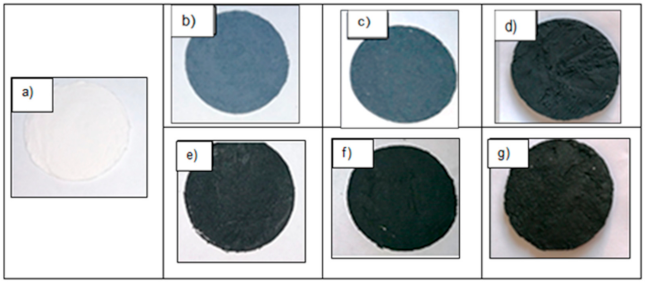
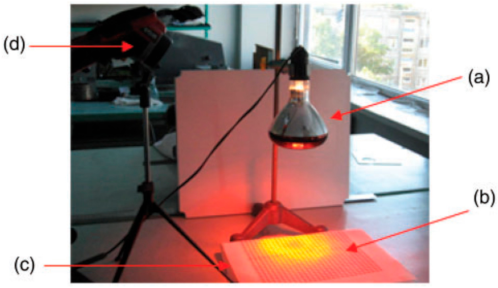


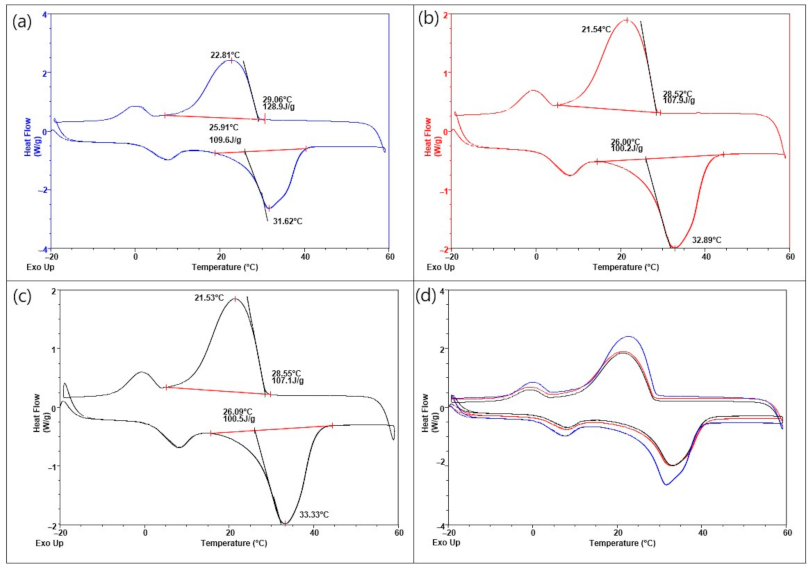
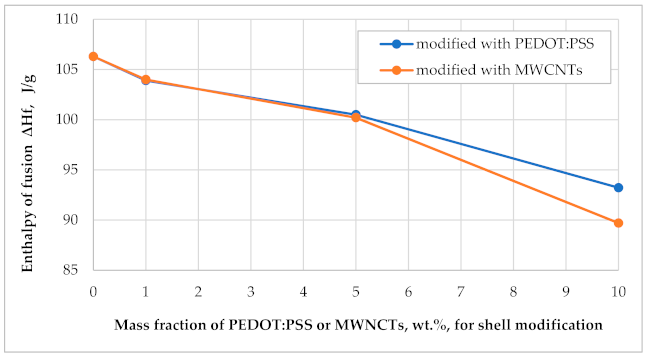
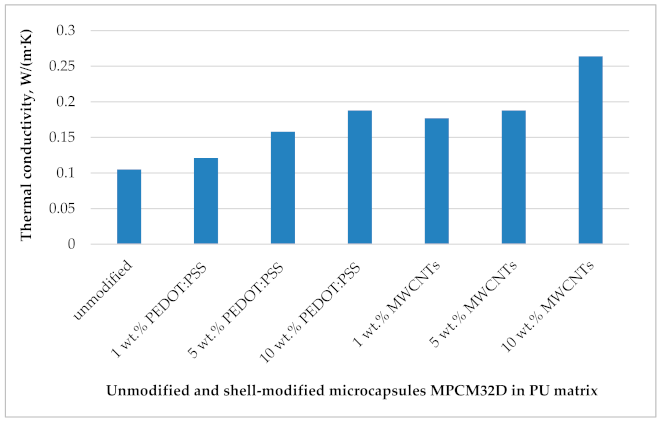
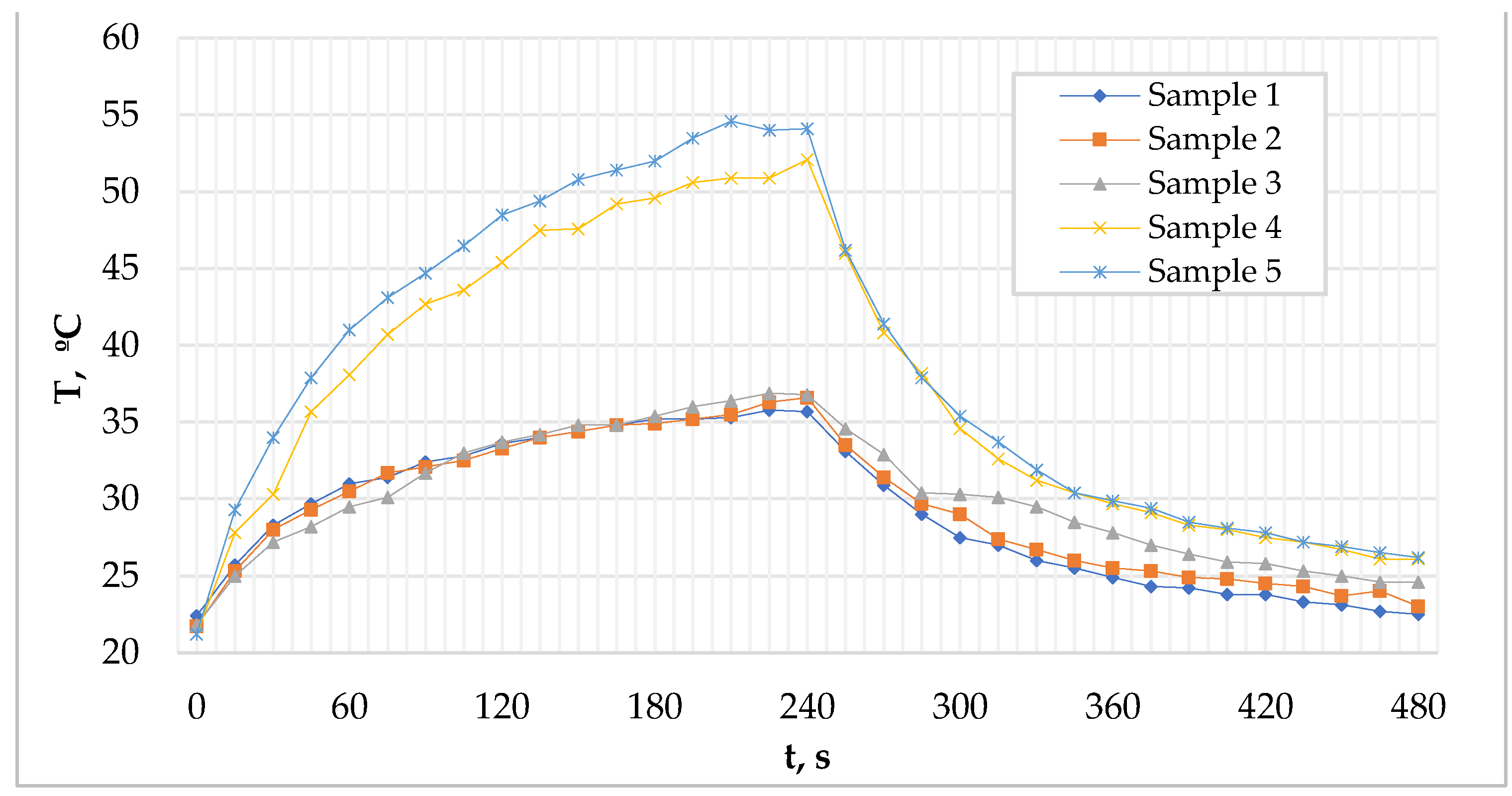
| 3D Warp-Knitted Spacer Fabric View—Warp-Wise | Type of Yarn and Linear Density, Tex | Content of Yarn, % | Mass per Unit Area, g/m2 | Thickness, mm |
|---|---|---|---|---|
 | PET textured, 11.0 | 70 | 358 | 2.9 |
| PET monofilament, 5.6 | 20 | |||
| Elastane, 7.8 | 10 |
| No. | Process | Auxiliaries | Parameters | |
|---|---|---|---|---|
| Microcapsules MPCM32D, g/L | Itobinder PCM, g/L | |||
| 1 | Dip coating with microcapsules MPCM32D: Unmodified 5 wt.% MWCNTs shell-modified 5 wt.% PEDOT: PSS shell-modified | 66 | 200 | Wet pick-up: 80% Nip rolls: 2 bar |
| 2 | Drying—curing | Temperature: 120 °C | ||
| Time: 6–8 min | ||||
| Microcapsules MPCM32D | Melting | Crystallization | ||||||
|---|---|---|---|---|---|---|---|---|
| Peak Melting Temperature, Tp.m. °C | Extrapolated Onset Melting Temperature, Tei.m.°C | Extrapolated End Melting Temperature, Tef.m. °C | Enthalpy of Fusion, ΔHf, J/g | Peak Crystallization Temperature, Tp.c.°C | Extrapolated Onset Crystallization Temperature, Tei.c. °C | Extrapolated End Crystallization Temperature, Tef.c. ° C | Enthalpy of Crystallization, ΔHc, J/g | |
| Unmodified (initial) | 32.02 | 13.19 | 40.09 | 106.3 | 21.44 | 30.61 | 5.49 | 113.0 |
| Modified with PEDOT:PSS: | ||||||||
| 1 wt.% | 32.73 | 15.68 | 44.9 | 103.9 | 21.56 | 30.13 | 5.01 | 112.9 |
| 5 wt.% | 33.33 | 15.56 | 45.06 | 100.5 | 21.53 | 30.25 | 3.95 | 108.5 |
| 10 wt.% | 33.49 | 15.4 | 44.9 | 93.22 | 21.27 | 29.8 | 4.09 | 103.1 |
| Modified with MWCNTs: | ||||||||
| 1 wt.% | 33.85 | 15.0 | 42.2 | 104.0 | 22.9 | 30.3 | 5.31 | 106.1 |
| 5 wt.% | 32.89 | 14.49 | 45.42 | 100.2 | 21.54 | 29.42 | 4.42 | 108.7 |
| 10 wt.% | 33.35 | 14.85 | 43.05 | 89.77 | 22.21 | 31.3 | 5.25 | 96.4 |
| Sample Code | Method of Textile Sample Treatment | Thermal Resistance, Rct (m2∙K/W) | Thermal Conductivity Coefficient, λ (W/(m·K)) |
|---|---|---|---|
| 1 | Untreated (initial) | 0.068 | 0.043 |
| 2 | Dip-coated with Itofinish PCM | 0.069 | 0.042 |
| 3 | Dip-coated with Itofinish PCM and unmodified microcapsules MPCM32D | 0.073 | 0.039 |
| 4 | Dip-coated with Itofinish PCM and 5 wt.% PEDOT:PSS shell-modified microcapsules MPCM32D | 0.061 | 0.047 |
| 5 | Dip-coated with Itofinish PCM and 5 wt.% MWCNTs shell-modified microcapsules MPCM32D | 0.060 | 0.048 |
| Sample Code | Knitted Fabric with Microcapsules MPCM32D | Melting | Crystallization | ||
|---|---|---|---|---|---|
| Peak Melting Temperature, Tp.m, °C | Enthalpy of Fusion, ΔHf, J/g | Peak Crystallization Temperature, Tp.c, °C | Enthalpy of Crystallization, ΔHc, J/g | ||
| 3 | Unmodified | 31.66 | 21.78 | 24.78 | 24.64 |
| 4 | 5 wt.% PEDOT:PSS shell-modified | 31.42 | 22.71 | 24.28 | 23.19 |
| 5 | 5 wt.% MWCNTs shell-modified | 31.42 | 24.22 | 24.65 | 26.31 |
Publisher’s Note: MDPI stays neutral with regard to jurisdictional claims in published maps and institutional affiliations. |
© 2021 by the authors. Licensee MDPI, Basel, Switzerland. This article is an open access article distributed under the terms and conditions of the Creative Commons Attribution (CC BY) license (https://creativecommons.org/licenses/by/4.0/).
Share and Cite
Skurkyte-Papieviene, V.; Abraitiene, A.; Sankauskaite, A.; Rubeziene, V.; Baltusnikaite-Guzaitiene, J. Enhancement of the Thermal Performance of the Paraffin-Based Microcapsules Intended for Textile Applications. Polymers 2021, 13, 1120. https://doi.org/10.3390/polym13071120
Skurkyte-Papieviene V, Abraitiene A, Sankauskaite A, Rubeziene V, Baltusnikaite-Guzaitiene J. Enhancement of the Thermal Performance of the Paraffin-Based Microcapsules Intended for Textile Applications. Polymers. 2021; 13(7):1120. https://doi.org/10.3390/polym13071120
Chicago/Turabian StyleSkurkyte-Papieviene, Virginija, Ausra Abraitiene, Audrone Sankauskaite, Vitalija Rubeziene, and Julija Baltusnikaite-Guzaitiene. 2021. "Enhancement of the Thermal Performance of the Paraffin-Based Microcapsules Intended for Textile Applications" Polymers 13, no. 7: 1120. https://doi.org/10.3390/polym13071120
APA StyleSkurkyte-Papieviene, V., Abraitiene, A., Sankauskaite, A., Rubeziene, V., & Baltusnikaite-Guzaitiene, J. (2021). Enhancement of the Thermal Performance of the Paraffin-Based Microcapsules Intended for Textile Applications. Polymers, 13(7), 1120. https://doi.org/10.3390/polym13071120





